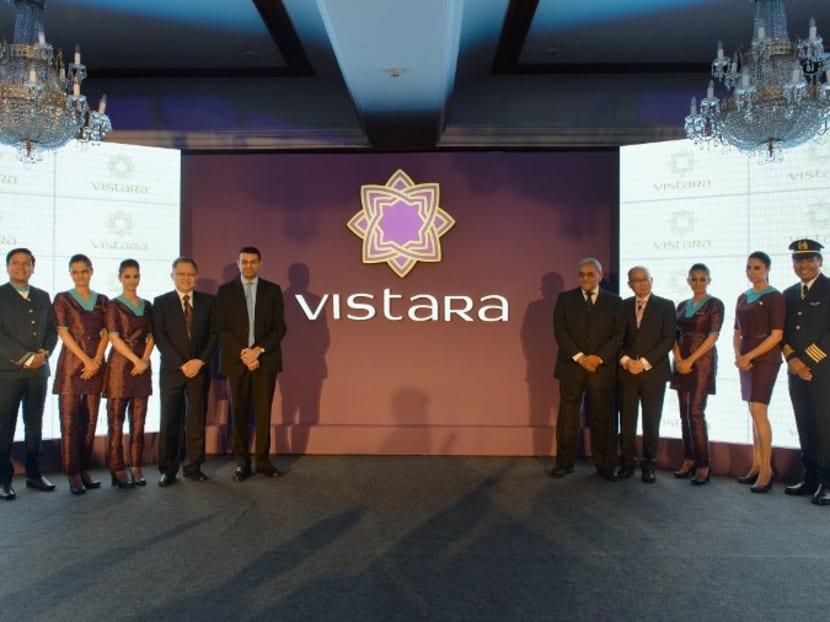Singapore Airlines’ India unit to challenge Gulf carriers’ dominance
NEW DELHI — Within weeks of India easing aviation rules, Singapore Airlines’ local venture is charting a course to take on carriers from the Middle East. It’s counting on a surge in international traffic from the world’s fastest growing major air-travel market.

The launch of the airline Vistara, a partnership of Singapore Airlines and Tata Group, in New Delhi in 2014. AFP file photo
NEW DELHI — Within weeks of India easing aviation rules, Singapore Airlines’ local venture is charting a course to take on carriers from the Middle East. It’s counting on a surge in international traffic from the world’s fastest growing major air-travel market.
Vistara, in which Singapore’s flag carrier owns 49 per cent, is considering buying or leasing wide-bodied aircraft for long-haul routes and will seek funds from its owners to finance the purchase, Chief Executive Phee Teik Yeoh said in an interview on June 24. Vistara, which has 11 planes in its fleet and is co-owned by India’s Tata Sons, needs at least nine more to fly abroad under the relaxed policy.
The number of international travellers from India is poised to grow 10-fold to 500 million by 2050, according to a CAPA Centre of Aviation study that was commissioned by Vistara.
The carrier’s plans may be the start of a fresh challenge for Emirates Airline and Etihad Airways PJSC that have long been the biggest foreign carriers in India and have, along with Air India and Jet Airways India, dominated the market for offshore travel.
“We believe Vistara may pull out all stops to get to the 20 number and fly overseas,” said Amber Dubey, the New Delhi-based India head for aerospace at KPMG. “Being an Indian carrier, they will have the advantage of providing non-stop flights from India to the European Union and US, something that Gulf carriers can’t do.”
Prime Minister Narendra Modi’s Cabinet ratified its policy changes in aviation on June 15, permitting domestic airlines to fly overseas, provided they deploy 20 planes or 20 per cent of capacity, whichever is higher, on local routes. Earlier, carriers needed to have a minimum of 20 aircraft in their fleet and five years of domestic services.
“The world is our oyster now, we are spoiled for choice,” Mr Yeoh of Vistara said. “We can be East-bound, West-bound, we can be short-haul or long-haul from New Delhi.”
ADVANCING DELIVERY
The wide-bodied planes Vistara is considering would be in addition to the 20 it would have by June 2018 after leasing company BOC Aviation delivers nine more jets from Airbus Group SE’s A320 family, Mr Yeoh said.
Vistara is “seriously looking” at advancing the delivery schedule of those nine aircraft to enable overseas flights sooner, he said.
Singapore Airlines remains open to all options on funding Vistara, the carrier said in an e-mailed response, without elaborating. Tata Sons referred queries to Vistara. Spokesmen at Emirates and Etihad couldn’t immediately be reached for comments.
MAMMOTH TASK
At least 81 foreign carriers vie for passengers flying to and out of India, with Emirates and Etihad in the lead, followed by others including Qatar Airways, Singapore Airlines and Deutsche Lufthansa.
Etihad and its local partner Jet Airways together carried 2.4 million passengers to and from India during the first three months of this year, while state-run former monopoly Air India carried 2.1 million, data from the aviation regulator showed.
“It will be a mammoth task taking on the Middle East carriers now or in the near future,” said Mr Shukor Yusof, founder of aviation consultant Endau Analytics in Malaysia. “As it stands, the Middle East airlines are peerless in terms of money and products.”
FAILED ATTEMPT
Still, the size of the Indian market and its potential growth may offer room for more operators. Just 1 per cent to 2 per cent of India’s population flies now, compared with 40 per cent of the global population, according to the Sydney-based CAPA Centre study.
Air travel in the South Asian country grew more than 20 per cent last year, according to the International Air Transport Association (IATA). In comparison, passenger traffic in China rose about 10 per cent and that in the US grew by less than five per cent, IATA said in a December presentation.
Tata Sons, the holding company of India’s biggest conglomerate, set up Vistara with Singapore Airlines after an earlier attempt by the two partners in the mid-1990s failed. The carrier, which started flying in January 2015, now offers 18 domestic destinations with 487 daily flights.
Vistara is drawing up a 10-year plan for its growth in India, Mr Yeoh said. The wide-bodied planes it plans to acquire could be bought directly from manufacturers, bought and then sold to lessors to be leased back, or leased outright, he said, without elaborating on which option was preferred.
“International is not going to be a walk in the park,” Mr Yeoh said. “We are not in a hurry to grow old, we’d like to be nimble but we have big ambitions.” BLOOMBERG





